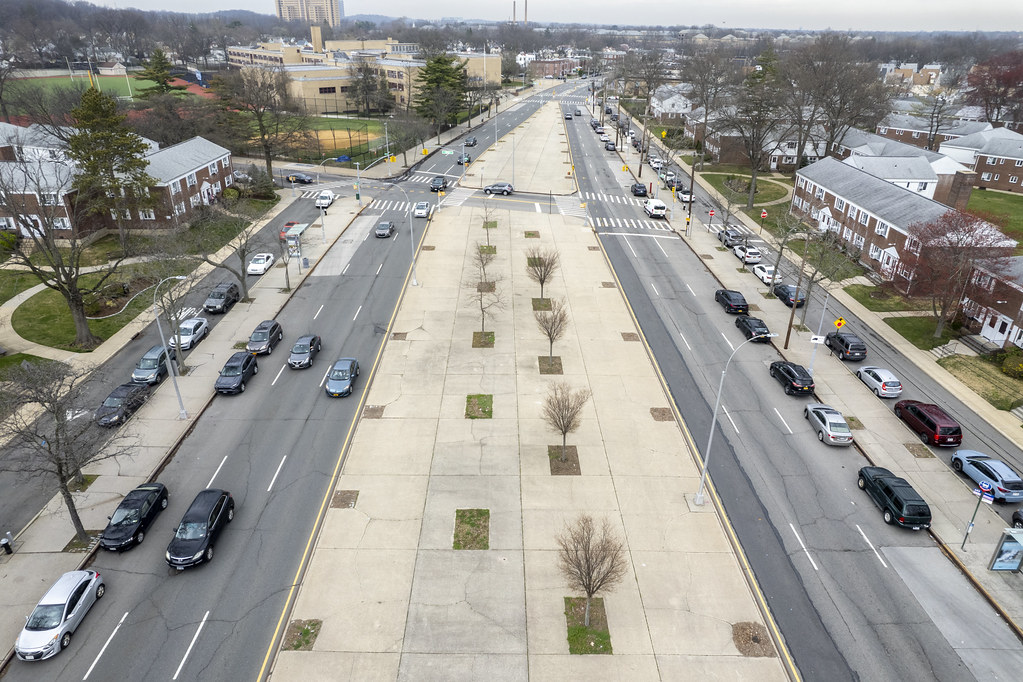To Better Manage Extreme Rainfall, Large Concrete Medians in Queens Village are Being Transformed into Resilient Green Infrastructure Sponges
October 18, 2023
The Seven New Green Spaces will Capture a Minimum of 5 Million Gallons of Stormwater Annually; Maps, Renderings and Photos are Available on DEP’s Flickr Page
Replacing Concrete with Native Plantings and Trees will also Lower Summer Temperatures, Improve Air Quality and Provide a Habitat for Pollinators and other Threatened Species
New York City Department of Environmental Protection (DEP) Commissioner Rohit T, Aggarwala today announced that work is underway to transform seven large concrete medians in Queens Village into green infrastructure sponges that will absorb stormwater and reduce neighborhood flooding.
“Climate change is bringing us more intense rainstorms and in order to manage all that stormwater we must replace impermeable concrete and asphalt with soil and plantings that will absorb water,” said DEP Commissioner Aggarwala. “We will transform these large, little-used medians into resilient, hardworking green infrastructure that will manage more than 5 million gallons of stormwater every year.”
By absorbing a minimum of 5 million gallons of stormwater annually from Hillside Avenue and Winchester Boulevard in the vicinity of Martin Van Buren High School, the green infrastructure medians will create additional capacity in the neighborhood’s sewer system which will help to reduce local flooding and any sewer overflows into Jamaica Bay. The $3.9 million project, including removal of the existing concrete and soil, installation of subsurface drainage infrastructure, back-filling, some concrete work and planting, is anticipated to continue for up to twelve months.
“As construction begins to mitigate stormwater flooding, the City is showing its commitment to prioritizing climate resiliency,” said City Council Member Linda Lee. “Due to the burdens of our changing climate, residents in Queens Village, and parts of Eastern and Southeast Queens, have become highly susceptible to flooding. These measures to add almost 3 acres of green infrastructure and improve New York City’s flood mitigation efforts exemplify our City’s endeavors to prepare our neighborhoods for the harmful effects of severe weather. I am thankful for the leadership of Mayor Adams and the New York City Department of Environmental Protection, as the City begins work on this green initiative that will ultimately save lives in the process.”
“I am delighted to see concrete replaced by grass,” said NYS Senator Toby Ann Stavisky. “These new green spaces will help alleviate the growing flooding issues our community faces while beautifying the neighborhood. I thank the Department of Environmental Protection for tackling this critical issue with such a creative and environmentally friendly approach.”
“We have recently seen how devastatingly damaging even a short rainfall can be to people, property and our neighborhoods,” said NYS Senator Leroy Comrie. “Our city and state must do all we can to mitigate the hazards of climate change and I commend Commissioner Aggarwala and DEP for the impending work to replace impermeable concrete medians with plantings and trees that will provide natural drainage and help reduce flooding in Queens Village. Expanding and enhancing our resiliency tools in our local infrastructure is the right step towards improving our environment for all New Yorkers."
In total, nearly three acres, or more than 121,600 square feet, of what is currently impermeable concrete will be removed and rebuilt with subsurface drainage chambers and engineered rock and soil and planted with ornamental grasses and perennial wildflowers in order to absorb the rain that falls on it and adjacent roadways, or a minimum of 5 million gallons annually. Additional large concrete medians in Queens will be transformed into resilient green infrastructure medians beginning next year, with other sites in the planning and design stages.
Over the last several years DEP’s nation-leading green infrastructure program has constructed more than 11,000 green infrastructure installations including curbside rain gardens, green roofs, subsurface detention, permeable pavers, concrete and asphalt, and now green medians have been added to the City’s drainage toolbox. All of these green installations intercept stormwater before it can drain into the sewer system, thereby creating additional capacity to help reduce flooding and sewer overflows into local waterways.
DEP manages New York City’s water supply, providing approximately 1 billion gallons of high-quality drinking water each day to nearly 10 million residents, including 8.5 million in New York City. The water is delivered from a watershed that extends more than 125 miles from the city, comprising 19 reservoirs and three controlled lakes. Approximately 7,000 miles of water mains, tunnels and aqueducts bring water to homes and businesses throughout the five boroughs, and 7,500 miles of sewer lines and 96 pump stations take wastewater to 14 in-city treatment plants. DEP also protects the health and safety of New Yorkers by enforcing the Air and Noise Codes and asbestos rules. DEP has a robust capital program, with a planned $31.3 billion in investments over the next 10 years. For more information, visit nyc.gov/dep, like us on Facebook, or follow us on X, formerly known as Twitter.





